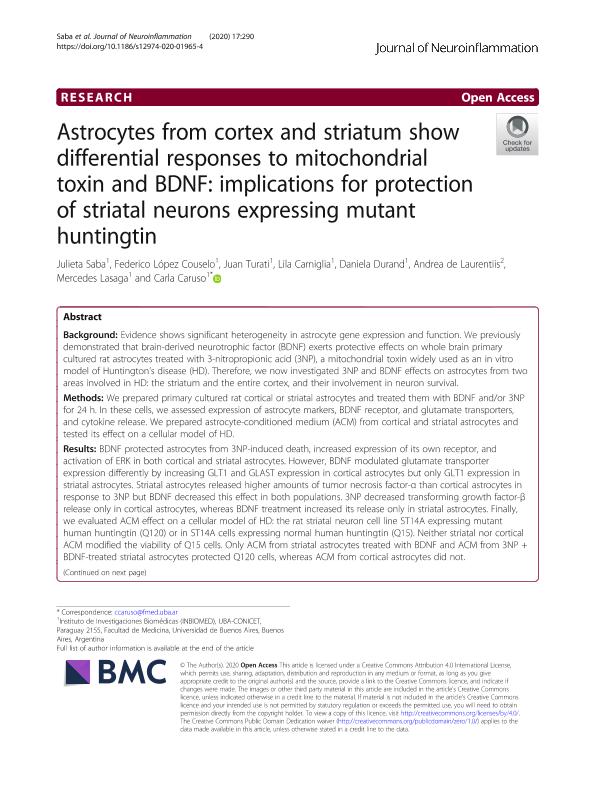Artículo
Astrocytes from cortex and striatum show differential responses to mitochondrial toxin and BDNF: Implications for protection of striatal neurons expressing mutant huntingtin
Saba, Julieta ; López Couselo, Federico
; López Couselo, Federico ; Turati, Juan
; Turati, Juan ; Carniglia, Lila
; Carniglia, Lila ; Durand, Daniela Elizabeth
; Durand, Daniela Elizabeth ; de Laurentiis, Andrea
; de Laurentiis, Andrea ; Lasaga, Mercedes Isabel
; Lasaga, Mercedes Isabel ; Caruso, Carla Mariana
; Caruso, Carla Mariana
 ; López Couselo, Federico
; López Couselo, Federico ; Turati, Juan
; Turati, Juan ; Carniglia, Lila
; Carniglia, Lila ; Durand, Daniela Elizabeth
; Durand, Daniela Elizabeth ; de Laurentiis, Andrea
; de Laurentiis, Andrea ; Lasaga, Mercedes Isabel
; Lasaga, Mercedes Isabel ; Caruso, Carla Mariana
; Caruso, Carla Mariana
Fecha de publicación:
10/2020
Editorial:
BioMed Central
Revista:
Journal Of Neuroinflammation
ISSN:
1742-2094
Idioma:
Inglés
Tipo de recurso:
Artículo publicado
Clasificación temática:
Resumen
Background: Evidence shows significant heterogeneity in astrocyte gene expression and function. We previously demonstrated that brain-derived neurotrophic factor (BDNF) exerts protective effects on whole brain primary cultured rat astrocytes treated with 3-nitropropionic acid (3NP), a mitochondrial toxin widely used as an in vitro model of Huntington’s disease (HD). Therefore, we now investigated 3NP and BDNF effects on astrocytes from two areas involved in HD: the striatum and the entire cortex, and their involvement in neuron survival. Methods: We prepared primary cultured rat cortical or striatal astrocytes and treated them with BDNF and/or 3NP for 24 h. In these cells, we assessed expression of astrocyte markers, BDNF receptor, and glutamate transporters, and cytokine release. We prepared astrocyte-conditioned medium (ACM) from cortical and striatal astrocytes and tested its effect on a cellular model of HD. Results: BDNF protected astrocytes from 3NP-induced death, increased expression of its own receptor, and activation of ERK in both cortical and striatal astrocytes. However, BDNF modulated glutamate transporter expression differently by increasing GLT1 and GLAST expression in cortical astrocytes but only GLT1 expression in striatal astrocytes. Striatal astrocytes released higher amounts of tumor necrosis factor-α than cortical astrocytes in response to 3NP but BDNF decreased this effect in both populations. 3NP decreased transforming growth factor-β release only in cortical astrocytes, whereas BDNF treatment increased its release only in striatal astrocytes. Finally, we evaluated ACM effect on a cellular model of HD: the rat striatal neuron cell line ST14A expressing mutant human huntingtin (Q120) or in ST14A cells expressing normal human huntingtin (Q15). Neither striatal nor cortical ACM modified the viability of Q15 cells. Only ACM from striatal astrocytes treated with BDNF and ACM from 3NP + BDNF-treated striatal astrocytes protected Q120 cells, whereas ACM from cortical astrocytes did not.Conclusions: Data suggest that cortical and striatal astrocytes respond differently to mitochondrial toxin 3NP and BDNF. Moreover, striatal astrocytes secrete soluble neuroprotective factors in response to BDNF that selectively protect neurons expressing mutant huntingtin implicating that BDNF modulation of striatal astrocyte function has therapeutic potential against neurodegeneration.
Archivos asociados
Licencia
Identificadores
Colecciones
Articulos(CEFYBO)
Articulos de CENTRO DE ESTUDIOS FARMACOLOGICOS Y BOTANICOS
Articulos de CENTRO DE ESTUDIOS FARMACOLOGICOS Y BOTANICOS
Articulos(INBIOMED)
Articulos de INSTITUTO DE INVESTIGACIONES BIOMEDICAS
Articulos de INSTITUTO DE INVESTIGACIONES BIOMEDICAS
Citación
Saba, Julieta; López Couselo, Federico; Turati, Juan; Carniglia, Lila; Durand, Daniela Elizabeth; et al.; Astrocytes from cortex and striatum show differential responses to mitochondrial toxin and BDNF: Implications for protection of striatal neurons expressing mutant huntingtin; BioMed Central; Journal Of Neuroinflammation; 17; 1; 10-2020; 1-15
Compartir
Altmétricas



